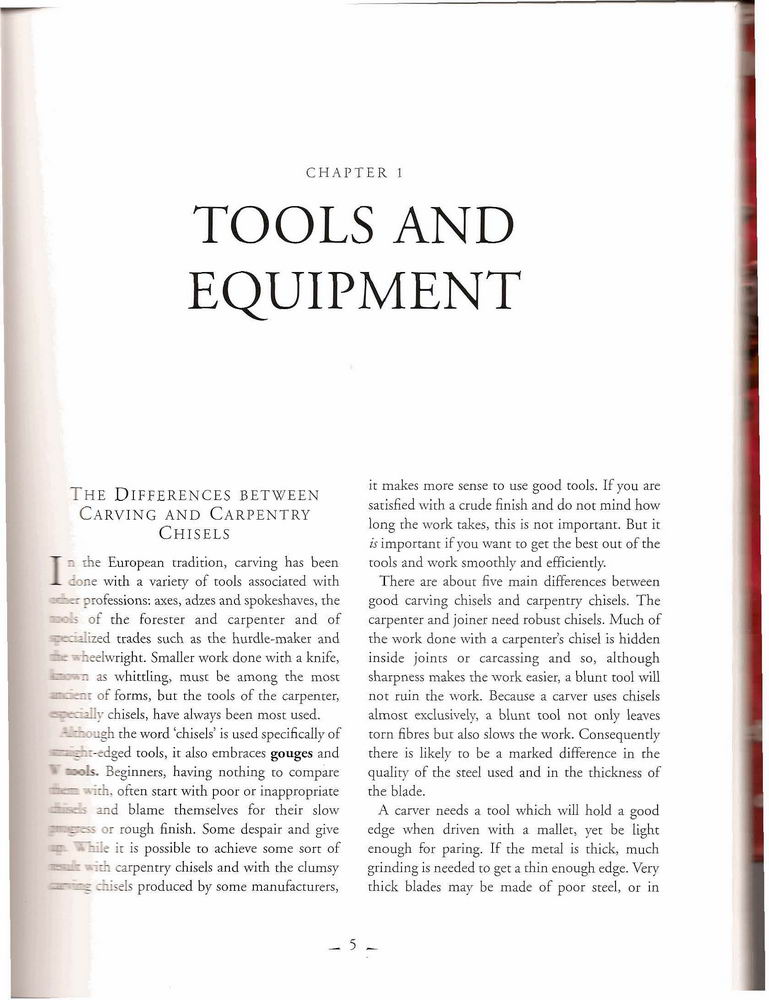essentÊrving°05

CHAPTER 1
TOOLS AND EQUIPMENT
The Differences between Carving and Carpentry Chisels
I" the European tradition, carving has bcen -one with a varicty of tools associated wilh . : professions: axes, adzes and spokeshaves, the :*:-5 of the forester and carpenter and of o.ized trades such as the hurdlc-maker and ~ '.eelwright. Smaller work done with a knife, r. as whittling, must be among the most of forms, but the tools of the carpenter, =ccc;Elv chisels, have always bcen most uscd.
â ugh the word chiselsâ is uscd specifically of ~ . -cdged tools, ir also cmbraces gougcs and ^ aools. Beginners, having nothing to compare ::h. oftcn start with poor or inappropriate and blame themselves for their slow or rough finish. Some despair and give it is possible to achieve some sort of tr i:h carpentry chisels and with the clumsy ââ ⢠c chisels produced by some manufacturcrs,
it makes morÄ scnse to use good tools. If you arc satisfied with a crude finish and do not mind how long the work takcs, this is not important. But it is important if you want to get the best out of the tools and work smoothly and efficiently.
There arc about five main differences between good carving chisels and carpentry chisels. The carpenter and joiner need robust chisels. Much of the work done with a carpcnters chisel is hidden inside joints or carcassing and so, although sharpness makes the work casier, a blunt tool will not ruin the work. Becausc a carver uses chisels almosc cxclusively, a blunt tool not only leaves torn fibres but also slows the work. Consequently there is likely to be a marked difference in the qualitv of the Steel used and in the thickness of the blade.
A carver needs a tool which will hoÅd a good edge when driven with a mallet, yet be light enough for paring. If the metal is thick, much grinding is needed to get a thin enough edge. Very thick bladcs may be madÄ of poor Steel, or in
- 5 «
Wyszukiwarka
Podobne podstrony:
Creative Doughcraft�2 Chapter 1Tools and materials You will already have the necessary tools and mat
essent?rving?27 CHAPTER 2SELECTING AND BUYING SUITABLE WOOD The Beginnerâs Experience Thcrc is
UHAM014 About this book In the first chapter, the differences between headaches and migraines are ou
roach 12 Weak forms Chapter 9 discussed the difference between strong and weak syllables in English.
When comparing and contrasting the similarities and differences between bridges and switches, which
Europa & USA the main difference betweenEuropÄ and USA
cw0032 UNITAdvertising D4® 31 Listen to the difference between /au/and /au/. /su/ as in go slow no&n
CCF20091103�002 5. THE DIFFERENCE BETWEEN MAIN THOUGHT AND KEYSENTENCE You are familiar with the fac
CCF20100223�012 The main difference between English and Polish diphthongs, and at the same time Åhe
PRZEDMIOTOWE EFEKTY KSZTAÅCENIA Z zakresu wiedzy: PEK_W01 Knows the difference between management an
21 Project oriented measures: The Labour Market Administration differentiates between individual job
Multimedia What Are the Differences Between the FAT FAT32 and NTFS File Systems Windows supports thr
74 2.5.9 Statistical analysis Data are expressed as mean ± SEM, and the significance of differences
CCF20100223�012 The main difference between English and Polish diphthongs, and at the same time the
wiÄcej podobnych podstron